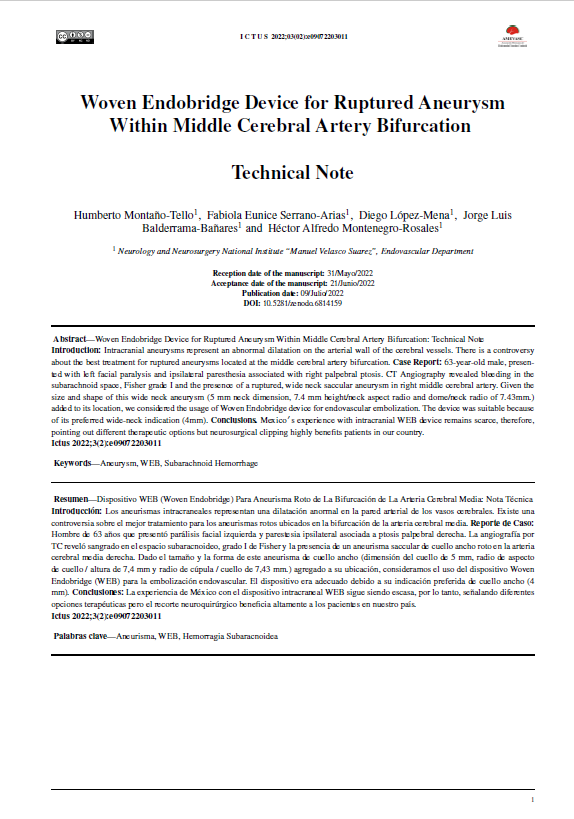Resumen
Introducción: Los aneurismas intracraneales representan una dilatación anormal en la pared arterial de los vasos cerebrales. Existe una controversia sobre el mejor tratamiento para los aneurismas rotos ubicados en la bifurcación de la arteria cerebral media. Reporte de Caso: Hombre de 63 años que presentó parálisis facial izquierda y parestesia ipsilateral asociada a ptosis palpebral derecha. La angiografía por TC reveló sangrado en el espacio subaracnoideo, grado I de Fisher y la presencia de un aneurisma saccular de cuello ancho roto en la arteria cerebral media derecha. Dado el tamaño y la forma de este aneurisma de cuello ancho (dimensión del cuello de 5 mm, radio de aspecto de cuello / altura de 7,4 mm y radio de cúpula / cuello de 7,43 mm.) agregado a su ubicación, consideramos el uso del dispositivo Woven Endobridge (WEB) para la embolización endovascular. El dispositivo era adecuado debido a su indicación preferida de cuello ancho (mayor/igual 4 mm). Conclusiones: La experiencia de México con el dispositivo intracraneal WEB sigue siendo escasa, por lo tanto, señalando diferentes opciones terapéuticas pero el recorte neuroquirúrgico beneficia altamente a los pacientes en nuestro país.
Referencias
Toth G, Cerejo R. Intracranial aneurysms: Review of current science and management. Vasc Med [Internet]. 2018;23(3):276–88. Disponible en: http://dx.doi.org/10.1177/1358863X18754693
Pierot L, Spelle L, Cognard C, Szikora I. Wide neck bifurcation aneurysms: what is the optimal endovascular treatment? J Neurointerv Surg [Internet]. 2021 [citado el 27 de abril de 2022];13(5):e9. Disponible en: https://jnis.bmj.com/content/13/5/e9
Procedural complications of endovascular treatment in patients with aneurysmal subarachnoid haemorrhage treated at a single centre. Alanen M, Pyysalo L, Jalava I, et al. Acta Neurochir, 2018;160:551–557. [PubMed] [Google Scholar]
Caroff J, Neki H, Mihalea C, D’Argento F, Abdel Khalek H, Ikka L, et al. Flow-diverter stents for the treatment of saccular middle cerebral artery bifurcation aneurysms. AJNR Am J Neuroradiol [Internet]. 2016;37(2):279–84. Disponible en: http://dx.doi.org/10.3174/ajnr.A4540
De Leacy RA, Fargen KM, Mascitelli JR, et al. Wide-neck bifurcation aneurysms of the middle cerebral artery and basilar apex treated by endovascular techniques: a multicentre, core lab adjudicated study evaluating safety and durability of occlusion (BRANCH). J Neurointerv Surg 2019;11:31–6.
Muskens IS, Senders JT, Dasenbrock HH, et al. The Woven Endobridge device for treatment of intracranial aneurysms: a systematic review. World Neurosurg 2017;98:809–17.
Arthur AS, Molyneux A, Coon AL, Saatci I, Szikora I, Baltacioglu F, et al. The safety and effectiveness of the Woven EndoBridge (WEB) system for the treatment of wide-necked bifurcation aneurysms: final 12-month results of the pivotal WEB Intrasaccular Therapy (WEB-IT) Study. J Neurointerv Surg [Internet]. 2019 [citado el 24 de marzo de 2022];11(9):924–30. Disponible en: https://jnis.bmj.com/content/11/9/924
Karhunen V, Bakker MK, Ruigrok YM, Gill D, Larsson SC. Modifiable risk factors for intracranial aneurysm and aneurysmal subarachnoid hemorrhage: A Mendelian randomization study. J Am Heart Assoc [Internet]. 2021;10(22):e022277. Disponible en: https://www.diva-portal.org/smash/get/diva2:1617103/FULLTEXT01.pdf
Saavedra CR, Rangel CC, Pichardo Uribe OA, Benavides OC, Orijel AP. Reconstrucción endovascular de aneurisma intracraneal mediante dispositivo diversor de flujo Pipeline® Reporte de 2 casos y revisión de la literatura. Rev Fac Med UNAM [Internet]. 2019 [citado el 24 de marzo de 2022];62(3):20–6. Disponible en: https://www.medigraphic.com/cgi-bin/new/resumen.cgi?IDARTICULO=86939
Zhang X, Tang H, Huang Q, Hong B, Xu Y, Liu J. Total hospital costs and length of stay of endovascular coiling versus neurosurgical clipping for unruptured intracranial aneurysms: Systematic review and meta-analysis. World Neurosurg [Internet]. 2018;115:393–9. Disponible en: http://dx.doi.org/10.1016/j.wneu.2018.04.028
Popielski J, Berlis A, Weber W, Fischer S. Two-center experience in the endovascular treatment of ruptured and unruptured intracranial aneurysms using the WEB device: A retrospective analysis. AJNR Am J Neuroradiol [Internet]. 2018;39(1):111–7. Disponible en: http://dx.doi.org/10.3174/ajnr.a5413
Asnafi S, Rouchaud A, Pierot L, Brinjikji W, Murad MH, Kallmes DF. Efficacy and safety of the Woven EndoBridge (WEB) device for the treatment of intracranial aneurysms: A systematic review and meta-analysis. AJNR Am J Neuroradiol [Internet]. 2016;37(12):2287–92. Disponible en: http://dx.doi.org/10.3174/ajnr.A4900
Pierot L, Cognard C, Anxionnat R, Ricolfi F, CLARITY Investigators. Endovascular treatment of ruptured intracranial aneurysms: factors affecting midterm quality anatomic results: analysis in a prospective, multicenter series of patients (CLARITY). AJNR Am J Neuroradiol [Internet]. 2012;33(8):1475–80. Disponible en: http://dx.doi.org/10.3174/ajnr.A3003
Goyal N, Hoit D, DiNitto J, Elijovich L, Fiorella D, Pierot L, et al. How to WEB: a practical review of methodology for the use of the Woven EndoBridge. J Neurointerv Surg [Internet]. 2020 [citado el 25 de marzo de 2022];12(5):512–20. Disponible en: https://jnis.bmj.com/content/12/5/512

Esta obra está bajo una licencia internacional Creative Commons Atribución 4.0.
Derechos de autor 2022 Ictus

